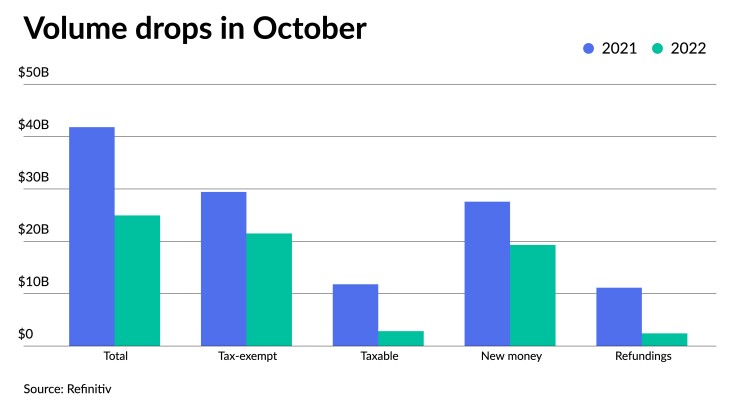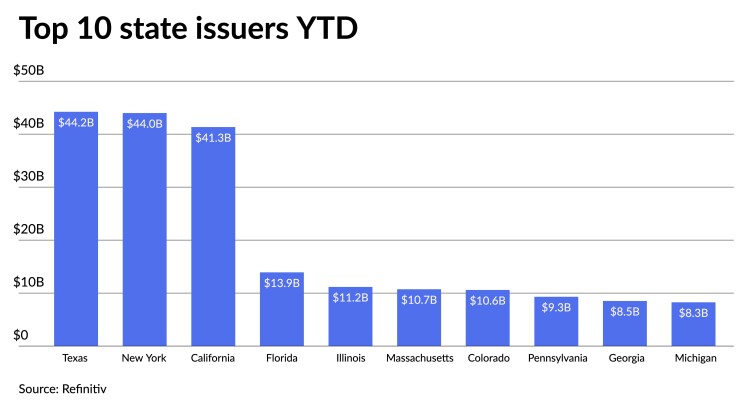October municipal bond issuance declined 40.3% year-over-year, as issuers dealt with extremely volatile rates, market fatigue and the upcoming Federal Open Market Committee meeting that begins Tuesday.
Total October volume was $24.951 billion in 510 deals versus $41.811 billion in 1,068 issues a year earlier, according to Refinitiv data. Taxable issuance totaled $2.845 billion in 36 issues, down 75.9% from $11.804 billion in 185 issues a year ago. Tax-exempt issuance was down 26.9% to $21.506 billion in 472 issues from $29.433 billion in 877 issues in 2021 and alternative-minimum tax issuance rose to $600 million, 4.4%, from $574.7 million.
New-money issuance fell 30% to $19.315 billion in 474 transactions from $27.574 billion a year prior.

Refunding volume decreased 78.2% to $2.424 billion from $11.144 billion in 2021.
Historically, October tends to be a pretty strong month for issuance, but that wasn't the case in 2022.
While in the early weeks of the month, the calendar was coming back, healthier than where it had been, but the sell-off for the last two weeks and the high volatility of U.S. Treasuries made it harder for issuers to come to market, said Barclays strategist Clare Pickering.
"Every change, every dip, every rally, every selloff, it's getting harder and harder," she said.
Dealers also are hesitant to want to hold inventory if the deal is not well received.
"No one wants to take that risk, so they put it off," she said.
October is sandwiched between two Federal Open Market Committee meetings: September when the Fed hiked rates 75 basis points and November when another 75 basis point rate hike is expected, according to Matt Fabian, a partner at Municipal Market Analytics.
It's harder for issuers to price into this market as buyers want to get ahead of potential losses that might be coming through the FOMC, he said.
Dealers, he noted, are pricing bonds cheaper because buyers want to take as little risk as possible of near-term losses when they purchasenew paper. "It makes life harder on the underwriters because you can plan for this kind of transaction or that kind of transaction but when supply is lumpy, buyer demand are inconsistent," he said.
"Issuers are just trying to hold," he said. "It makes sense for issuers to wait. It would make sense that issuers are pulling back, waiting for the Fed to stop, and then maybe, we'll come with a bit more issuance."
And "the higher and more volatile that rates get, the more difficult it is for issuers to do refundings," he said.
Generally, state and local credit quality is good, and most of the refundings they have done in the last couple of years have been "scoop up" jobs to generate cash-flow savings, Fabian noted.
"So, if they don't need cash-flow savings, and the rates are ugly, that makes sense that they would pull back from taxable refundings," he said, noting the market is unlikely to see the level of taxable refundings it saw in 2020 and 2021 in the near future.
Despite the decrease in issuance, October saw several billion-dollar deals come to market, he said.
For the remainder of the year, he said, "It's hard to assume that things are going to get much better for issuance and product." His initial issuance prediction for 2022 stood at $475 billion. That figure has been revised downward to $50 billion to $425 billion.
Barclays, though, has not updated its supply projections for the year and Pickering said its 2022 projections are in range. Going into 2022, Pickering and fellow Barclays strategists Mikhail Foux and Mayer Patel predicted total issuance would be $430 billion to $450 billion, which included $110 billion of taxable bonds with municipal CUSIPs and $25 billion with corporate CUSIPs.
She said if the November FOMC meeting goes as expected, there may be opportunities for the market to settle.
The drop in issuance year-to-date is a function of this year of issuers pulling back and is part a trend that's likely to extend into next year as issuers become a little more careful about new investment, Fabian said.
"You don't have an investor base yet that's coming together and saying, 'Now's the time,'" Pickering said.
However, she noted, "there's only one direction after this," though she can't time that exactly right now. "I think you're feeling that across markets," she said.
BofA strategists recently released their projections for 2023, with their preliminary target of total issuance at $500 billion, consisting of $380 million of new-money and $120 billion of refundings. This is up from their twice-revise projections for 2022, which they now believe will come in lower than $420 billion.
Next year "should be a much friendlier year as the Fed is expected to wrap up its intensive tightening program in the first few months, and eventually begin an easing cycle later in the year during a prolonged recession," they said.
Long-term muni rates, they noted, "should begin to decline after the second-to-last hike, and short maturity yields should begin to decline long before the actual Fed easing."
Additionally, BofA strategists said that "investor demand should rejuvenate as such high yields were rarely available in the past decade."
"Demand for new financing from muni issuers should see large growth, while refunding should rise above this year's dismal levels," they said.
Issuance details
Revenue bond issuance decreased 61.7% to $11.031 billion from $28.820 billion in October 2021, and general obligation bond sale totals rose 7.1% to $13.920 billion from $12.991 billion in 2021.
Negotiated deal volume was down 40.1% to $19.099 billion from $31.862 billion a year prior. Competitive sales decreased to $5.773 billion, or 28.5%, from $8.073 billion in 2021.
Deals wrapped by bond insurance dropped 45.9%, with $1.502 billion in 90 deals from $2.777 billion in 192 deals a year prior.
Bank-qualified issuance dropped to $683.7 million in 175 deals from $1.327 billion in 319 deals in 2021, a 48.5% decrease.

In the states, Texas claimed the top spot year-to-date.
Issuers in the Lone Star State accounted for $44.210 billion, down 3.8% year-over-year. New York was second with $43.980 billion, up 4%. California was third with $41.334 billion, down 37.8%, followed by Florida in fourth with $13.912 billion, down 7.8%, and Illinois in fifth with $11.157 billion, a 11.3% increase from 2021.
Rounding out the top 10: Massachusetts with $10.722 billion, up 8.2%; Colorado with $10.591 billion, down 3%; Pennsylvania with $9.302 billion, down 42.8%; Georgia at $8.511 billion, up 14.4%; and Michigan with $8.258 billion, up 5.7%.





